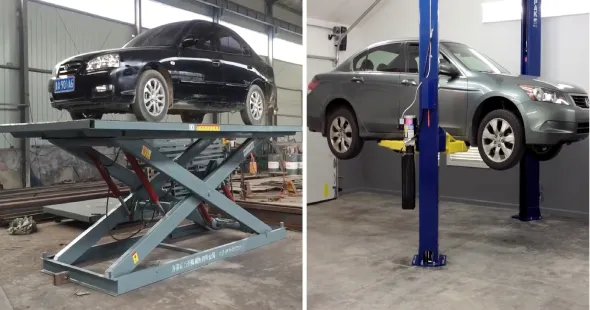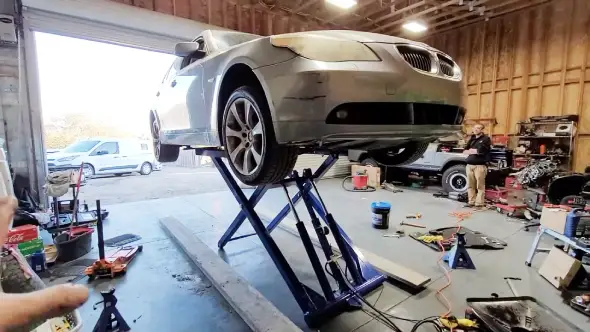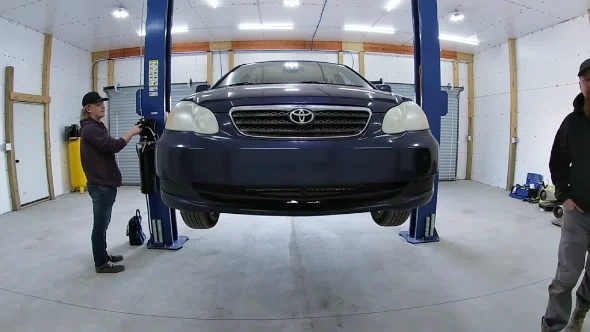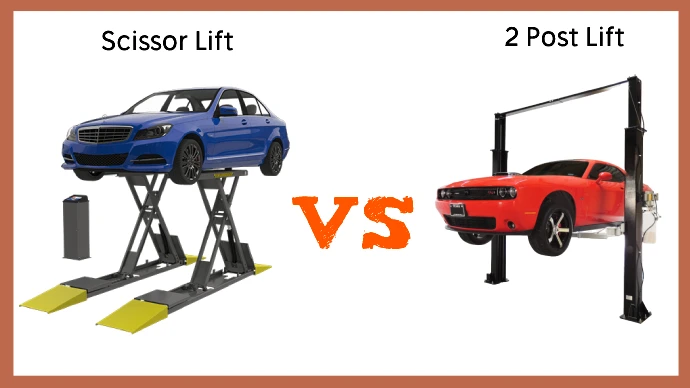Last Updated on April 5, 2023
Are you looking for the ideal lift system for your garage or shop? If so, you may have seen both scissor lift and 2 post lift systems. Both lifts offer great lifting power and convenience, but essential differences between them must be considered before deciding.
Scissor lifts are typically characterized by crisscrossed steel arms forming a triangle shape when fully extended. A switch or lever-activated hydraulic pump operates them.
In contrast, two post lifts usually consist of two vertical posts connected at the top with two horizontal arms that descend onto the car. Electronic controls are located on the posts for controlling these arms.
So what are their differences, and which will work better for you? Let’s take a closer look at their operation, lifting capacity, height, maneuverability, space requirements, and more.
The Difference Between Scissor Lift Vs 2 Post Lift When Lifting Vehicles

Regarding lifting vehicles, scissor lifts and two-post lifts are two of the most popular options. Scissor lifts offer a great deal of maneuverability and flexibility when compared to two-post lifts, which primarily provide stability and convenience.
Both have unique benefits, so here are the differences between them:
01: Design and Operation
Scissor lifts are designed with criss crossing arms connected to a base and elevated platform. The arms lift the platform, usually using an electric motor or hydraulic pump to raise or lower it.
Four adjustable legs support the platform. Scissor lifts typically operate via a control panel located at the corner of the lift, where users can direct the direction, speed, and height of the lift.
Conversely, 2 post lifts are designed with two independent vertical posts that support an overhead crossbeam. The posts are connected by hydraulic cylinders and powered by either electric or hydraulic motors.
They come with two sets of locking arms that secure vehicles from below. Operating these lifts requires synchronization between both columns when lifting heavier loads.
02: Lifting Capacity and Height
The maximum lifting capacity for scissor lifts varies depending on their design but can generally be up to 4.7 tons (10300 lbs). Although most models feature platforms up to 60 inches in width, some have been manufactured with media as wide as 100 inches.
In terms of height, they can usually reach up to 8 feet high when fully extended.
In comparison, 2 post lifts usually offer higher lifting capacities ranging up to 15 tons (30,000 lbs). These typically come in wider sizes than most scissor lift models. Its platforms range from 80 to 120 inches wide, while its maximum extended length ranges from 11 to 12 feet tall.
It’s worth noting that larger 2 post lifts may require higher ceilings for installation due to their large elevation range compared to scissor lifts.
03: Maneuverability and Space Requirements
Scissor lifts are highly maneuverable because they are small. They don’t need much space and can be stored in small places. Also, their compact design allows them to fit into tight spaces such as garages where there isn’t enough room for a full-sized lift bay for regular repair work on cars or light trucks.
Furthermore, the lack of dual posts gives technicians more elbow room when working under a vehicle compared to a 2 post lift. It allows them greater flexibility when moving around the car during repairs without having many obstructions from additional posts blocking their way.
2 post lifts are usually bulkier than scissor lifts because they have two columns. They usually take up more floor space than scissor lifts when fully extended. But they offer slightly more maneuverability than scissor models while servicing cars/light trucks.
Because of their longer runways, both sides of the columns extend further out. This makes it easier for technicians to reach those hard-to-reach areas of smaller vehicles without struggling too much inside tight spaces.
04: Applications and Suitability
A scissor lift is an ideal choice for lifting vehicles in places where space is restricted. Its advantages include a low profile design, so it can fit in narrow spaces, and a small footprint, allowing for storage when not in use. It also has quick setup times, and its ease of operation means one operator can use it.
In contrast, two post lifts are better suited to larger garages or bays with more space. They provide better stability and are often used to hold heavier vehicles in position while being worked on.
As they require less headroom than a scissor lift, they also work better for taller garages or bays with higher ceilings.
05: Safety and Regulatory Requirements
Regarding safety and regulatory requirements, both a scissor lift vs. two post lifts must comply with the relevant legislation regarding lifting operations. Scissor lifts must be operated cautiously due to the potential hazard of tipping over if overloaded or handled improperly.
On the other hand, 2 post lifts typically have an adjustable arm system which allows them to be set at different heights depending on the vehicle’s size. They’re safer than scissor lifts because they’re more stable and prevent tipping even at maximum height.
06: Cost and Maintenance Requirements
The cost of a scissor lift or two post lifts varies depending on the model. In general, two-post lifts are more expensive than scissor lifts because they can hold more weight and are more stable, making them a good choice for heavier vehicles like trucks or vans.
Maintenance of both lifts involves regular inspections and lubrication to ensure their safety and function.
What Are the Pros and Cons of a Car Scissor Lift?

There are several pros and cons of a scissor lift.
Pros:
- Car scissor lifts are an economical and space-efficient way to lift vehicles of all sizes, from cars to SUVs and light trucks. They take up less space than other lifts, such as a two-post lift.
- Scissor lifts are typically less expensive than other car lifts, making them an ideal option for home garages or small businesses on a budget.
- Not only do scissor lifts work for different size vehicles, but they can also be used for various automotive repairs, including painting and detailing work.
- Due to their low profile design, car scissor lifts allow technicians to access tight spots otherwise inaccessible to other types of lifts.
- Many newer models have safety features like emergency stop buttons and overload sensors that help prevent accidents or injuries.
Cons:
- Car scissor lifts have a limited lifting height compared to other lifts, so they may not be suitable for taller vehicles or jobs requiring higher elevation levels.
- Scissor lifts have a limited weight capacity compared to two-post lifts, making them not strong enough to handle heavy-duty applications.
- It can take longer to lift a vehicle than other types of lifts due to their slower lifting speed and potential weight limitations.
- Scissor lifts can be more dangerous because they can tip over if not used properly or overloaded beyond their capacity limits. In tight spaces or low ceiling areas, the low profile of the lift could create further hazards. During an operation, someone could get caught in the moving parts.
What Are the Pros and Cons of a 2 Post Car Lift?

You may also want to consider the pros and cons of a two post lift.
Pros:
- A two-post car lift is a great way to work on your vehicle safely, as it eliminates the risk of the car falling off jacks or stands.
- They are easy-to-access, hard-to-reach areas of your vehicle, allowing you to work more efficiently and accurately.
- Can handle heavier vehicles than scissor lifts, making them a better option for larger or heavier cars, SUVs, or light trucks.
- They have a faster lifting speed that can take anywhere from 20 to 60 seconds.
- 2-post car lifts also provide convenience as they can easily be moved around or shifted from one area to another within your garage or workshop.
Cons:
- Two-post car lifts tend to be more expensive than other types, such as scissor lifts.
- Installing them correctly requires a lot of space which might not be available in smaller garages or workshops.
- And they require a certain amount of skill and knowledge to operate correctly and safely.
- To install safely, a thick floor base should be used at least 4 inches thick to support the load the two post-car lifts will carry.
Why Do Car Scissor Lifts Wobble?
The most common reason for car scissor lifts wobbling is because of an uneven surface. If the surface isn’t level, the lift won’t be able to sit securely on the ground and will start to shake or wobble as weight is added.
It’s also possible that the lift joints are too stiff or have too much friction, which can cause instability. And windy conditions can make a scissor lift more prone to wobbling, so it’s important to check the weather before using one outdoors.
To reduce wobbling and ensure your safety while using a scissor lift, ensure you’re working on a level surface and that all joints are properly lubricated with low-friction grease. Also, never use an outdoor scissor lift if winds blow more than 25 mph.
Taking these precautions will help keep you safe while using your car scissor lift.
Can Scissor Lifts and 2 Post Lifts Be Used Interchangeably?

Scissor lifts are a good choice for lifting vehicles to a moderate height, such as for tire and brake repairs, oil changes, and other routine maintenance tasks. They are also popular in small garages and workshops, where space is premium.
Alternatively, 2 post lifts are ideal for lifting larger vehicles. They are often used in larger auto repair shops or car dealerships for tasks such as transmission, suspension work, and other significant repairs requiring greater access to the vehicle’s underside.
While both types of lifts share some similarities, such as their ability to lift vehicles off the ground, they are designed for different tasks and have extra weight capacities, lifting heights, and safety features.
So, they are not interchangeable, and selecting the correct lift type for the specific task is essential.
Which Automotive Lift is Right for You?
When choosing between scissor lifts and two post lifts, it’s essential to consider factors like design and operation, lifting capacity and height, maneuverability and space requirements, safety regulations, cost and maintenance requirements.
All these play an essential role in deciding which is correct for you. Ultimately the choice between these two types of lift will depend on your specific needs, budget constraints, available space, and safety regulations in your area.
If you’re still uncertain about which lift is most appropriate for your needs, don’t hesitate to reach out to a professional who can guide you in selecting the perfect option for your project.
